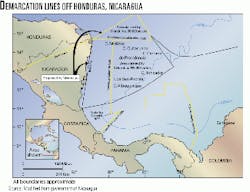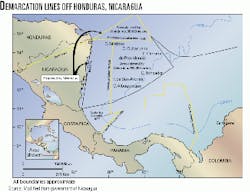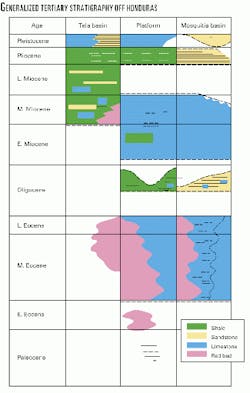A long-simmering dispute over a maritime boundary in the southwestern Caribbean, a region thought to hold potential hydrocarbon reserves, broke into an angry argument between Honduras and Nicaragua at the end of last year.
As yet the two countries have not gone past mutual accusations into actual military conflict, but Nicaraguan President Arnoldo Aleman and top Nicaraguan generals briefly threatened to attack Honduras if it did not recognize Nicaragua's claims to a portion of the continental shelf off both countries' Caribbean coast.
Nicaragua filed a suit against Honduras in December in the International Justice Court in The Hague, and bilateral talks with international mediation are under way to avoid an escalation of the disagreement. The threat of military action looks remote, and the case is destined to wind its way slowly through the court at The Hague. It is not likely to be resolved before 2003 at the earliest.
The Honduran government had been trying to encourage private companies to explore for oil in the area, which is thought to hold potential hydrocarbon reserves. But Nicaragua's unexpected claim seems likely to put exploration efforts on hold for the time being.
Until the dispute is resolved, the countries will be unable to derive economic benefit from hydrocarbons that might be discovered in the area.
A tangled history
Nicaragua's protest was sparked by the Nov. 30, 1999 ratification by the Honduran Congress of a maritime limits treaty between Honduras and Colombia. Jose Rene Gutierrez Huete, Nicaragua's ambassador in Honduras, said his country had two-fold grounds for disagreeing with that treaty.
First, the ambassador said, the treaty accepted as fact that Colombia's jurisdiction in the Caribbean extends as far west as 82degrees W. Long. This jurisdiction dates from a 1928 treaty between Nicaragua and Colombia, recognizing Colombia's control over the San Andres Islands. Nicaragua argues that the 1928 treaty is invalid, signed under pressure of the US to compensate Colombia for its US-engineered loss of Panama in the early 20th century.
Secondly, Gutierrez claimed that the Honduras-Nicaraguan maritime boundary should not be along 15degrees N. Lat., a boundary Nicaragua had in the past generally recognized. Instead, the boundary should be a diagonal line extending northeast from the land borders of the two countries northeast into the Caribbean as far north as 17degrees N. Lat.
Gutierrez pointed out that it is common practice for countries to divide their continental shelf using an equidistant line projecting from the land border. If done, that would back up Nicaragua's claims.
Nicaragua's government will "challenge" any petroleum concessions granted by Honduras in the disputed region, Gutierrez said, though he declined to be more specific about Nicaragua's possible response.
Carlos Lopez Contreras, a former Honduran foreign minister and his country's co-representative at the Hague court, countered that Nicaragua never made any complaints about Honduran oil concessions issued in the 1980s and 1990s for the disputed area. Lopez confirmed that his government would not hesitate to offer further oil concessions as far south as the 15th parallel and in agreement with the new treaty with Colombia. "We will continue to exercise our sovereignty in the area, as we always have," he said.
In the past, the International Justice Court has tended to favor upholding past treaties, suggesting Nicaragua may have a hard time winning its case. The recent Honduras-Colombia treaty, which provoked Nicaragua's ire, is already registered with the United Nations and considered binding by international law.
Regional geology
The triangular-shaped region claimed by both countries, which covers approximately 30,000 sq km, is a section of the Mosquitia basin, considered by petroleum geologists to be one of the most prospective in both countries.
As the maritime boundary currently stands, Honduras and Nicaragua share the Mosquitia basin more or less equally, though Honduras has slightly more of the basin's thickest sedimentary section. This thickest part, trending roughly northeast-southwest along the boundary between the two countries but currently on the Honduran side, lies directly under the waters Nicaragua claims.
A recent review of past seismic studies and drilling in Honduras by JGI, a division of Japan Exploration (Japex), contracted by the Honduran government to help promote oil exploration, pointed to the offshore portion of the Mosquitia basin as the most promising region in the country for hydrocarbons.
"We identify that the possible matured source rocks (have) been developed in the deepest part of the Mosquitia Basin near Nicaraguan border, where hydrocarbons generated and expelled may have migrated upward," the report's introduction states. "Then they may have possibly been trapped within shallow marine clastics and carbonates."
Several private companies, most from the US, have drilled a total of 13 wells between 1962 and 1983 and acquired around 20,000 km of seismic lines. Union Oil drilled the successful Main Cape well to TD 3,449 m (subsea) in 1973. It conducted three production tests in the Eocene, showing light oil and gas.
Union must have been encouraged, as it drilled another well 115 miles away at Gorda Bank later the same year, to 1,942 m (subsea). The organic material found was considered to be too young to generate oil or gas. The most promising source rock found in all the offshore drilling was in the Eocene, while the Cretaceous appeared unlikely source rock.
Mario Castaneda, former director of the Honduran government's Direccion General de Minas e Hidrocarburos, believes more investigation is necessary to determine the Mosquitia basin's potential. "The density of drilling needs to increase to find out if there are any reserves," Castaneda said. "The geology is very complicated, and changes rapidly, which to me means the density of drilling needs to increase greatly for us to know with any exactitude whether reserves exist."
The last company to hold a concession offshore in the Mosquitia basin was Kelpetro. The Honduran government suspended the concession in 1996. Neither Honduras nor Nicaragua produce hydrocarbons.




